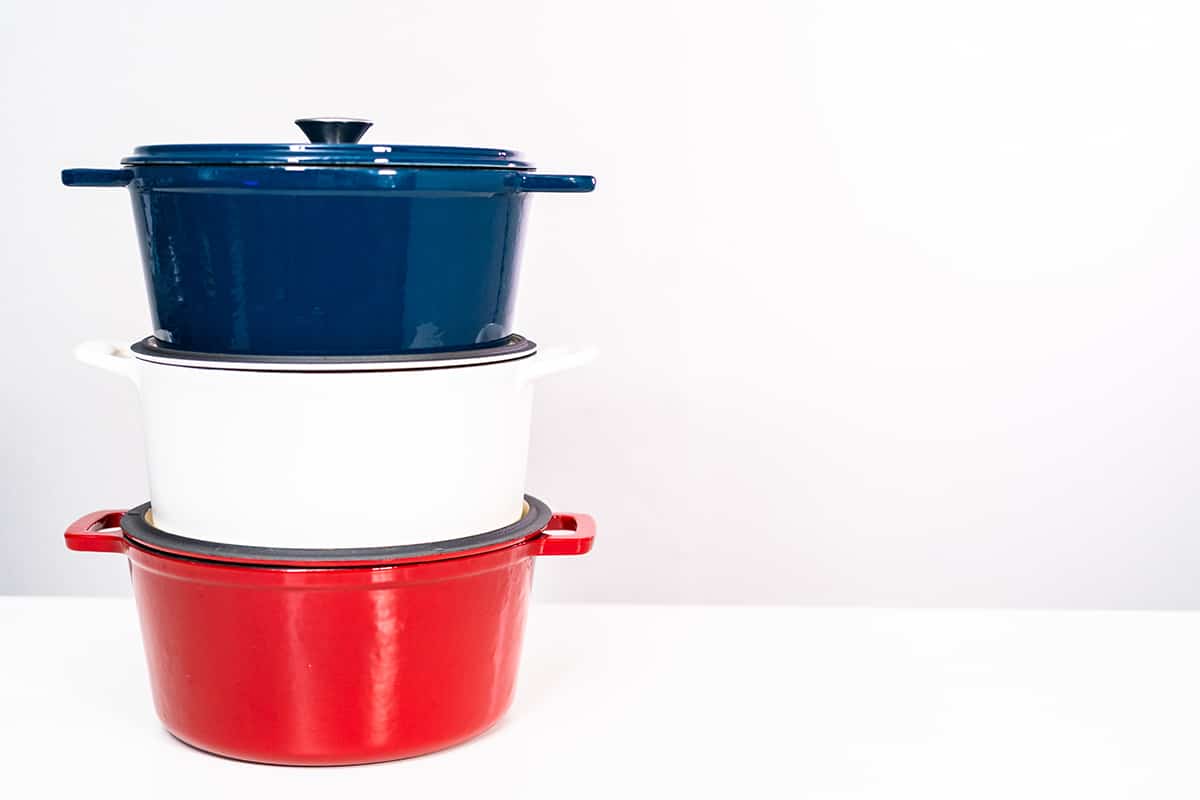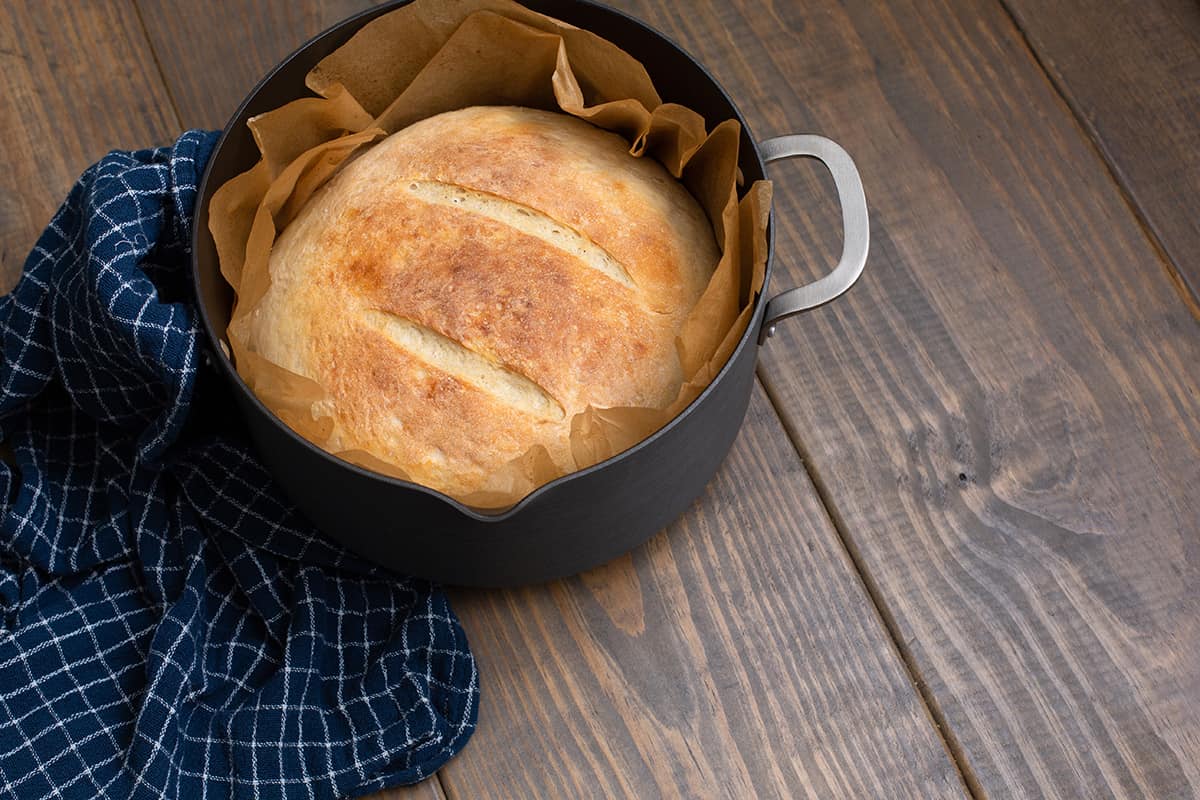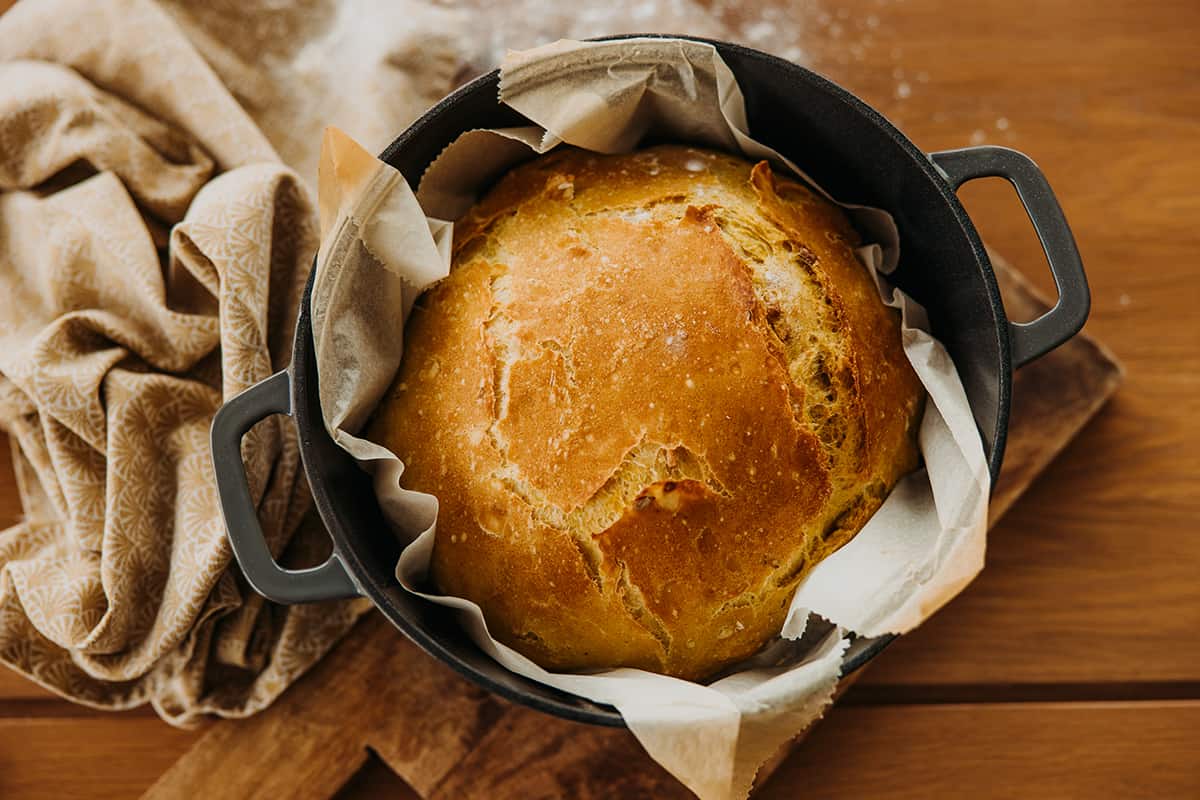Dutch ovens are great for all sorts of things, from making stews to proofing dough. You can even put the dough in a Dutch oven and bake it! So, if you’re going to make bread, what size Dutch oven should you get?
The ideal Dutch oven size for baking bread is 5 quarts. It provides enough space for the raw dough to grow while baking, and there’s enough vertical clearance in the pot to prevent the baked bread from overflowing.
In today’s guide, I’ll speak about different Dutch oven sizes, what they’re good for, and how to choose the right Dutch oven for your kitchen adventures.
What Is a Dutch Oven?
Dutch ovens are heavy pots with heavy lids. They typically come with 2 handles on opposite ends for lifting and moving from counter to stove/oven and back. The heavy lids provide somewhat of an airtight seal to prevent moisture from leaking out. Its heavy-duty construction makes it a must-have for all home cooks who love experimenting with different dishes.
The great thing about Dutch ovens is that they are not one-trick ponies. You can use a Dutch oven for nearly any method of cooking, from deep-frying French fries to slow-cooking stews on the stove and even baking bread.
Depending on the material and the finish, you can take a Dutch oven out to the wilderness to prepare all sorts of strange and exotic dishes. You’ll find all sorts of YouTube Shorts and TikTok videos that display this very activity in Dutch ovens.
Dutch Oven Sizes

Dutch ovens come in a variety of shapes and sizes. The typical Dutch oven is a massive 3-plus-quart beast for making soups, but they can be as small as 1 quart for making sad, single-person stews.
The following table will describe the various Dutch oven sizes, dimensions, and common uses.
| Dutch Oven Size | Dimensions | Common Uses |
| 1 quart | 6.65 × 4.25 in. | Side dishes, desserts, single-portion dishes |
| 1.5 quarts | 8.25 × 4.1 in. | Side dishes, desserts, generous single-portion dishes |
| 2 quarts | 9.25 × 5.24 in. | 2-person dishes |
| 3 quarts | 10 × 5 in. | Generous 2-person dishes |
| 4.5 quarts | 10 × 5.65 in. | Dinners for 2 to 3 people |
| 5 quarts | 11 × 5.4 in. | Single-pot dinners for 3+ people |
| 5.5 quarts | 12.87 × 6.57 in. | Deep frying, stews |
| 6 quarts | 13.25 × 6.4 in. | Deep frying, stews |
| 7 quarts | 12.65 × 6.6 in. | Deep frying, stews |
| 7.5 quarts | 14.2 × 6.7 in. | Deep frying, stews |
| 9 quarts | 15.8 × 5.7 in. | Deep frying, stews |
Of course, you can use any Dutch oven size for nearly anything you want, including baking and roasting.
Dutch Oven Size for Bread
One of the trendiest ways of baking bread is by throwing a developed dough ball in a Dutch oven before transferring it to a hot oven to bake. Basically, after you’ve prepared the bread dough, the Dutch oven (and your convection oven) will do all the work for you.
The great thing about Dutch ovens is that their perfectly round or oblong shapes make it so that you don’t have to shape the dough manually. The freshly baked bread will come out perfectly round or oval. All you really have to do is score the surface of the dough before popping the Dutch oven into your oven.
So, if you plan on turning a Dutch oven into a bread loaf pan, what size should you get?
It’s generally advised that you get a 5-quart Dutch oven. This is the perfect size for all sorts of bread types, including the classic sourdough, since it has a wide base and comes with tall side walls. In simple terms, 5-quart Dutch ovens have enough internal space to allow bread dough to rise and harden without getting in the way too much.
Other Dutch Oven Sizes for Baking Bread

However, as the size table above shows, the perfect Dutch oven size depends on how much dough you want to bake, as well as how many people you want to serve. You can get by with making single-portion servings of bread in 1- or 1.5-quart models, while Dutch ovens ranging between 5.5 and 7 quarts are ideal for parties.
However, you should probably stay away from massive (7.5-quart-plus) Dutch ovens for making bread. The problem is that the wider the base is, the shorter the bread will turn out. When making brioche and sourdough bread, you want the loaf to grow tall and wide. Dutch ovens with wider bases produce wider, thinner bread loaves.
In the end, the best Dutch oven size is that which accommodates your bread type the best. Perhaps you’re one of those people who prefer thin, crisper sourdough slices to tall and chewy ones!
How to Bake Bread in a Dutch Oven

After you’ve prepared your bread dough in a separate bowl, here’s how you bake the bread in a Dutch oven:
- Remove all racks in your oven except for one. The remaining rack should be at the center of the oven.
- Set your oven to 500°F and let it preheat for 10 to 20 minutes.
- When the oven has reached 500°F, place an empty Dutch oven with its lid inside and let it build heat for 30 to 45 minutes.
- After the Dutch oven is thoroughly hot, drop the oven’s temperature to 425 or 450°F.
- Carefully remove the lid from the Dutch oven and transfer the pre-made dough ball to the Dutch oven. Quickly shut the Dutch oven with its lid before shutting the oven door.
- Bake the bread based on the recipe’s instructions.
- When the bread is done baking, use potholders or oven mitts to remove the Dutch oven from the oven carefully.
- Remove the lid from the Dutch oven to allow the steam to vent.
- Wait for between 10 and 20 minutes before unmolding the bread from the Dutch oven.
If everything goes well, the bread should automatically release from the base and walls of the Dutch oven. You normally don’t have to grease a Dutch oven if you properly seasoned it.
The reason for pre-heating the Dutch oven is that cast iron takes much longer to heat up as opposed to aluminum or stainless steel. You want the pot to be scorching hot the second your dough ball touches the base of the Dutch oven. If the pot isn’t hot enough, the base and the sides of the bread may not be crispy enough.
How to Choose a Dutch Oven
Pay attention to the following criteria when choosing a Dutch oven.
Size
Simply put, size definitely matters when it comes to Dutch ovens. Larger Dutch ovens take much longer to heat up, but they can be used for making nearly anything you want, including doughnuts and steaks.
Enamel-coated vs. bare cast iron
Most Dutch ovens are made of cast iron, but some of them have a glossy enamel coating. An enamel-coated Dutch oven doesn’t require seasoning, so you can rely on its naturally non-stick properties to keep your bread loaves from sticking to the walls.
On the other hand, bare cast-iron Dutch ovens need to be seasoned properly, and you have to maintain their seasoning. However, because they don’t have a delicate glossy finish, you can take them out into the wilderness without worrying about how the terrain will affect their surface.
Shape
Dutch ovens are either round or oval in shape. The shape of the Dutch oven will affect the shape of your bread loaf. However, when using an oval Dutch oven on a stovetop, the sides of the pot may not be as hot as the center.






